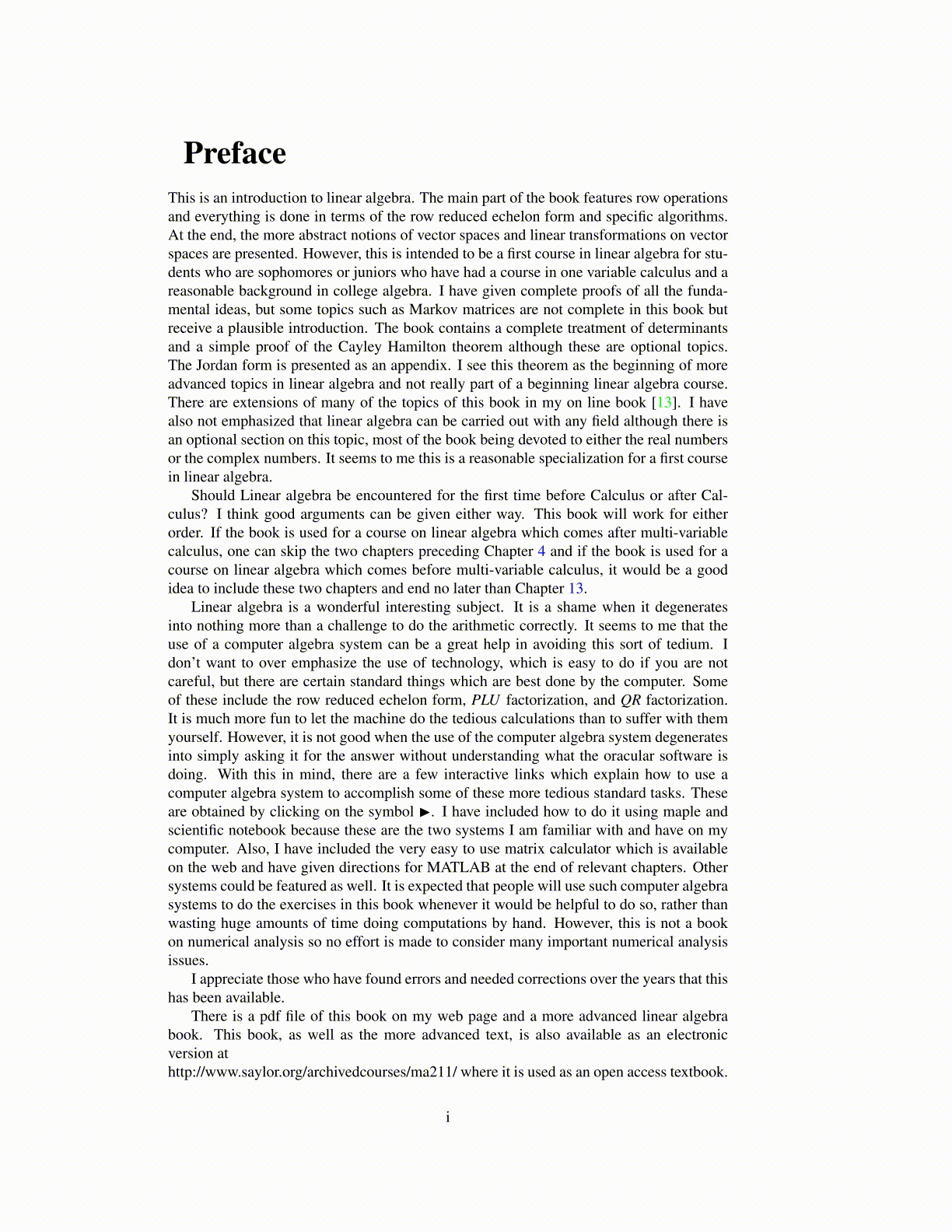
PrefaceThis is an introduction to linear algebra. The main part of the book features row operationsand everything is done in terms of the row reduced echelon form and specific algorithms.At the end, the more abstract notions of vector spaces and linear transformations on vectorspaces are presented. However, this is intended to be a first course in linear algebra for stu-dents who are sophomores or juniors who have had a course in one variable calculus and areasonable background in college algebra. I have given complete proofs of all the funda-mental ideas, but some topics such as Markov matrices are not complete in this book butreceive a plausible introduction. The book contains a complete treatment of determinantsand a simple proof of the Cayley Hamilton theorem although these are optional topics.The Jordan form is presented as an appendix. I see this theorem as the beginning of moreadvanced topics in linear algebra and not really part of a beginning linear algebra course.There are extensions of many of the topics of this book in my on line book [13]. I havealso not emphasized that linear algebra can be carried out with any field although there isan optional section on this topic, most of the book being devoted to either the real numbersor the complex numbers. It seems to me this is a reasonable specialization for a first coursein linear algebra.
Should Linear algebra be encountered for the first time before Calculus or after Cal-culus? I think good arguments can be given either way. This book will work for eitherorder. If the book is used for a course on linear algebra which comes after multi-variablecalculus, one can skip the two chapters preceding Chapter 4 and if the book is used for acourse on linear algebra which comes before multi-variable calculus, it would be a goodidea to include these two chapters and end no later than Chapter 13.
Linear algebra is a wonderful interesting subject. It is a shame when it degeneratesinto nothing more than a challenge to do the arithmetic correctly. It seems to me that theuse of a computer algebra system can be a great help in avoiding this sort of tedium. Idon’t want to over emphasize the use of technology, which is easy to do if you are notcareful, but there are certain standard things which are best done by the computer. Someof these include the row reduced echelon form, PLU factorization, and QR factorization.It is much more fun to let the machine do the tedious calculations than to suffer with themyourself. However, it is not good when the use of the computer algebra system degeneratesinto simply asking it for the answer without understanding what the oracular software isdoing. With this in mind, there are a few interactive links which explain how to use acomputer algebra system to accomplish some of these more tedious standard tasks. Theseare obtained by clicking on the symbol ▶. I have included how to do it using maple andscientific notebook because these are the two systems I am familiar with and have on mycomputer. Also, I have included the very easy to use matrix calculator which is availableon the web and have given directions for MATLAB at the end of relevant chapters. Othersystems could be featured as well. It is expected that people will use such computer algebrasystems to do the exercises in this book whenever it would be helpful to do so, rather thanwasting huge amounts of time doing computations by hand. However, this is not a bookon numerical analysis so no effort is made to consider many important numerical analysisissues.
I appreciate those who have found errors and needed corrections over the years that thishas been available.
There is a pdf file of this book on my web page and a more advanced linear algebrabook. This book, as well as the more advanced text, is also available as an electronicversion athttp://www.saylor.org/archivedcourses/ma211/ where it is used as an open access textbook.
i